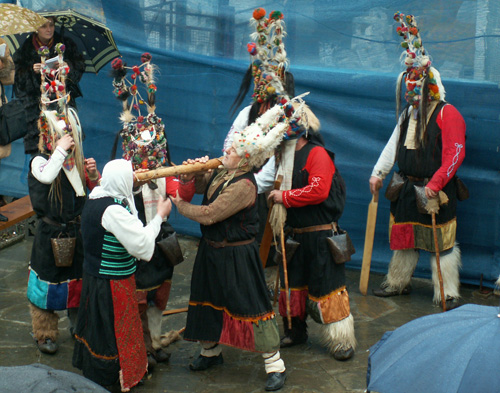Kukerovden - Mummer's day
Kuker (Мummer) is a young man wearing a costume and a mask (the ritual garments depends on the local traditions of each ethnographical group).
 Kukeri from Strandzha
Kukeri from Strandzha
This holiday takes place on the day preceding the second Sunday before Lent. The custom relates to the belief that it ensures fertility and abundance. The whole ritual complex of this custom is connected to the magical symbolic, which embodies the fertilizing of nature and its birth for a new life. Another function of this rite is to banish the evil spirits and everything charged with negative energy from the long winter period. The mummer’s rite originates in the ancient Thracian culture and preserved the whole Thracian ritual complex seeking to obtain fertility. Already in the 1st millennium BC, a great number of ancient authors describe these rites as the so called Dionysian Bacchanalia.
The custom consists in three main acts: the first one is called “trichene”; the second one is the mummer’s games: the mummer’s crowd dressed in white sheep pelts traverse the village square, while they are dancing wildly similar to the crowd of pans accompanying the Thracian God Dionysius; the third act is named “Pali kosh” (ritual burning of a basket full with straw).
Each of these events has its very own purpose. The “trichene” rite aids to cure the household animals from rabies; the burnt out straw has to help the chickens lay more eggs; while traversing the village area the masked performers dance and chase all misfortune, evil spirits dwelling inside the humans as well as those of the village area.
The leading characters in the mummer’s ritual complex are the King – a man from a good, stable and healthy family, he must be a person, who likes to work on the field and has a male first child; the Mummer – in Strandja Mountains the mummer is only one and he doesn’t wear ritual mask. His garment is made out of white sheep pelt and his face is paint in black. Additional he is wearing a hat and on his waist tightened with a rope, are hanging bells. Another irreplaceable belonging is the “pometash”, which is made out of a long rod ending with a rag. This rag is smudged and is used to mark the houses already visited by the mummer’s group. The most important belonging of the mummer is the ritual phallus representing the fertilizing power. It is made out of wood over painted with blue colour. When the mummer’s crowd finishes ploughing the first furrow in the village area, the mummer has to use the wooden phallus to fertilize the Mother Goddess - Earth; Secondary attendants of the feast are the Granny, the Bride, the Bridegroom, the Priest, the Bear, the Violinist and the Queen.
Wearing a mask is an act that comes from the depths of the human mind. Hidden behind a mask everybody could enter another world and become the hero, winning against all Evil.
Plamena Kirova
Traditionelle bulgarische Bräuche - Kukeri / Kukerovden (Deutsche Version herunterladen)









